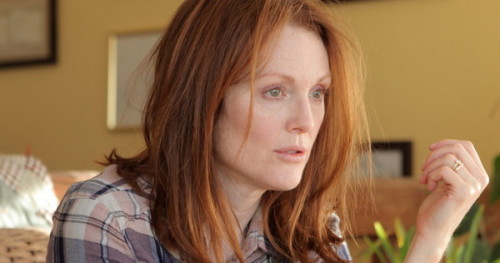This repost by Lisa Rosman appears as part of our theme week on the Academy Awards.
Without Julianne Moore, Still Alice might not be much of a film. This is not to say the adaptation of Lisa Genova’s 2007 novel about a 50-year-old woman stricken with early-onset Alzheimer’s disease is otherwise mediocre, although it is so unobtrusively constructed that its virtues may be overlooked. But because it focuses on the perspective of a person with Alzheimer’s rather than on the perspective of her caregivers, a uniquely gifted actor is required in the titular role. Who but Moore, with her radiant fusion of fortitude and empathy, could soldier us through a narrative whose unhappy ending is as inevitable as that of the Titanic?
Initially, Alice Howland seems like she has it all. A celebrated Columbia University linguistics professor, she is happily married to fellow academic John (an unusually muted Alec Baldwin), and the couple enjoys their three grown children as well as their well-appointed Long Island beach house and NYC brownstone. If she is a tad thorny when things don’t go her way – her youngest daughter, Lydia (Kristen Stewart), an aspiring actor, bears the brunt of her mother’s tenacity – it’s nothing extraordinary in a modern Type A woman. But when Alice can no longer write off her memory loss and growing confusion as mere middle-aged malaise (read: menopause side effects), her worst fears are outstripped: She is diagnosed with a rare strain of Alzheimer’s that is inherited and can be transmitted. “I wish I had cancer,” she weeps, and although some might take umbrage with her disease comparison-shopping, we understand what she means. Especially in her line of work, she does not know who she will be without her formidable brain.
Although this film is unwaveringly linear, we are quickly discombobulated. The film’s progression mirrors Alice’s decline so that time itself seems to dissolve, like all the rituals and goals to which she clings with a devastating inefficacy. Daily runs become impossible; soon she can no longer remember regular appointments without the aid of her smartphone. Sooner still she forgets the layout of her own house. One afternoon, she soils herself before she can find the bathroom. Every time Alice finds a way to manage a new set of limitations, the ground beneath her feet crumbles again, and we live right inside her growing panic and sorrow. As her ability to perceive her surroundings deteriorates, even the film’s clean lines grow fuzzy.
Because of Alice’s high intelligence, her Alzheimer’s has likely gone undiagnosed longer than it would have had she possessed fewer compensatory resources (ways to remember what she did not remember). The irony is she and her family possess very few “compensatory resources” once her now-rapid degeneration becomes evident; as cerebral people, they are especially ill-equipped to navigate her ever-increasing mental challenges. John, in particular, proves disappointing. “You are the smartest woman I know,” he tells her early on, and when their shared value of independence proves no longer possible, we learn that objectifying a woman for her brain is as problematic as objectifying her for her beauty. Marriage on any contingency plan is precarious.
It can be argued that Still Alice is too Lifetime-for-TV neat, that its secondary characters are too two-dimensional. While I’d never claim this film was avant-garde, I admire directors and screenwriters Richard Glatzer and Wash Westmoreland’s resistance to “fake stakes,” the peaks and valleys that normally shape a film narrative. Instead, the hurdles that Alice clears – an instance in which she successfully collects herself after dropping her notes during a speech, an aborted suicide attempt – only pave the way for our growing acceptance that there is no way to subvert her ultimate obstacle. Similarly, it makes sense that Alice’s family and friends don’t feel quite real; long before she actually forgets their names, her ability to distinguish personality nuance has been compromised. We’re there with her. Of course, this doesn’t excuse everything: a linguistics professor who loses her words is admittedly a smack on the nose, as is the discovery of Alice’s genetic disorder just as her eldest daughter (Kate Bosworth) is attempting to get pregnant.
What works beyond a shadow of a doubt is Moore herself. For a long time now, she has demonstrated an uncanny range and power without ever subjecting us to a shred of vanity. Here, she outdoes herself, channeling Alice’s physical, mental, and emotional devolution with an alchemy that is as thrilling as it is harrowing. Her luminous features slacken, her cadences falter, her life force fades. Scenes with Stewart are especially heartbreaking. The younger actor is finally returning to form after all that mucking about with vampires, and the careful attentiveness she displays as Alice’s daughter is key to the one hope that this film offers us: By definition, true love never changes form.
A former labor organizer, Lisa Rosman has reviewed film for such outlets as Time Out New York, Salon, Us Magazine, Flavorwire, LA Weekly, RogerEbert.com, and CBS News. She appears weekly on the NY1 film review show Talking Pictures and writes on film, feminism, and eavesdropping for SignsandSirens.com. Most notably, she once served as an assistant for Elmo on Sesame Street.






3 thoughts on “The Alchemy of ‘Still Alice’”
Comments are closed.